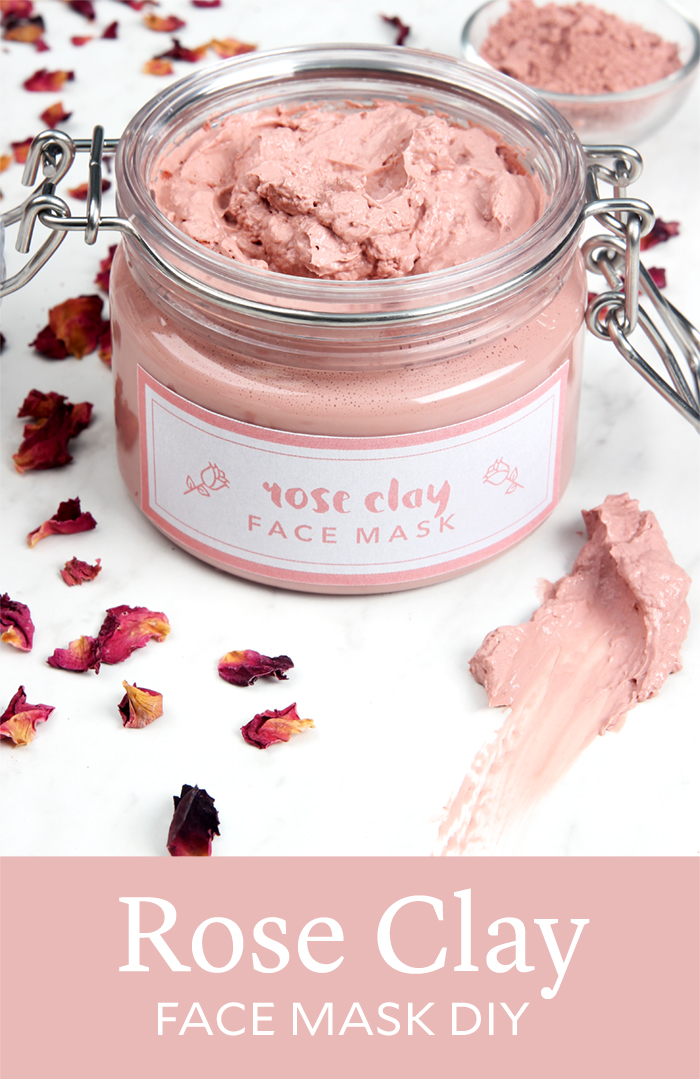
Rose clay is a naturally beautiful skincare ingredient. It adds a soft, rosy hue to this Rose Clay Face Mask. Rose clay has gentle oil-absorbing properties, making this mask suitable for both dry and oil skin types. Scented with rose absolute, this face mask is luxurious and pampering.
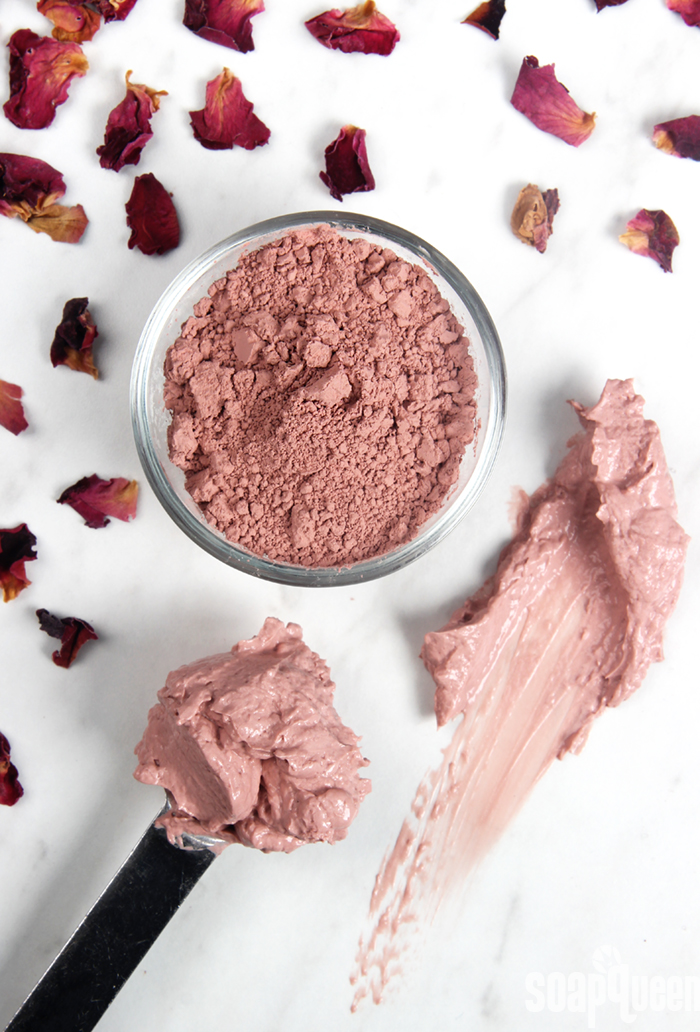
This face mask recipe was specifically designed with dry, mature skin in mind. Rosehip seed oil is rich in vitamin A and C, and intensely moisturizes without leaving a greasy feeling on the skin. Chamomile extract soothes dry skin, and is thought to be an anti-inflammatory. A downloadable label template gives a finished and polished look.
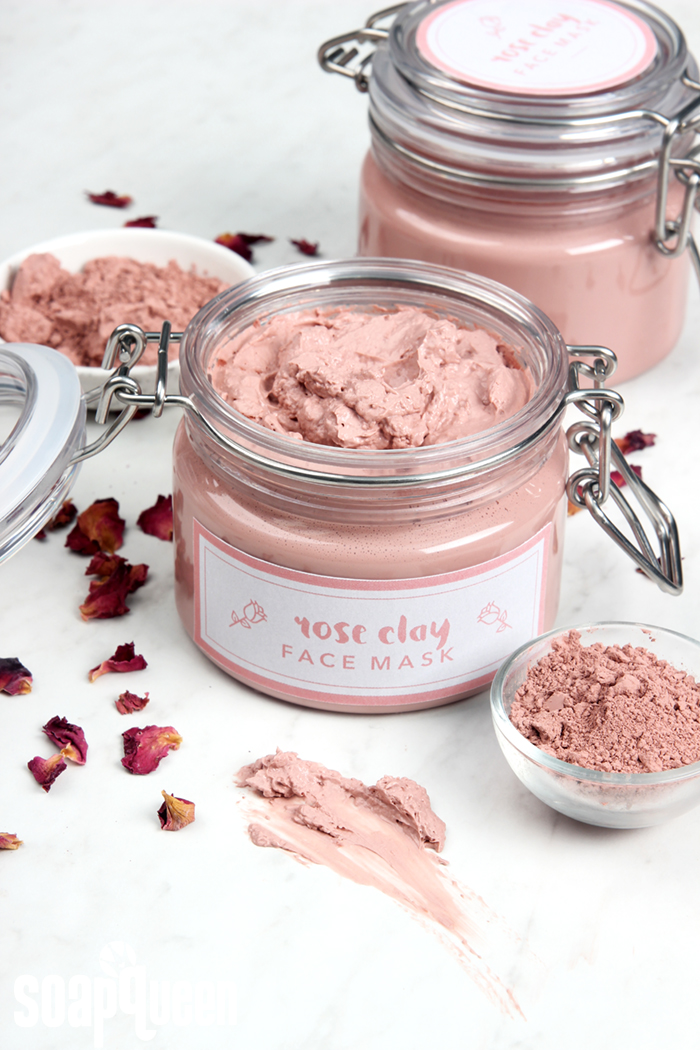
Rose absolute is extracted from rose petals, and gives the mask a soft, luxurious rose scent. It is a pricey essential oil, but you don’t need much at all. Just 1 mL of the oil is enough to elevate this mask to a truly pampering experience. If you don’t have dry or mature skin, there are three different variations of this mask recipe. This post will help you find which clay mask is right for your skin type.
A few notes about recipe substitutions:
- Polawax Emulsifying Wax is a highly reliable and strong emulsifier. It could be substituted for the generic version, Emulsifying Wax, if you prefer, although this recipe was not tested with Emulsifying Wax. Due to the clay in the recipe, we splurged and used Polawax Emulsifying Wax to avoid any chance of separation.
- This recipe calls for avocado and rosehip seed oil. Other oils can be used instead if you prefer; we recommend staying with liquid oils that absorb easily into the skin. Changing the total amount of oil in the recipe will change the overall texture of the mask.
- Because this recipe is essentially a lotion and contains a large amount of water, a preservative is necessary to prevent mold and bacterial growth. We chose Optiphen, but other water soluble preservatives will work. Learn more about preservatives here.
- Increase the total amount of clay if you want it to be better suited for normal to oily skin types. Decreasing the amount of clay may create a thinner product with more moisturizing properties.
- If you prefer to use different clays, feel free to swap them. Clays have different absorbing properties, which will affect how it feels on the skin. Learn which clay is right for your skin.
- If you have very sensitive skin, fragrance and essential oils can be irritating. Omit from the recipe if you prefer. Or, you can sub out the essential oil for a different oil.
What You’ll Need:
Four Short 8 oz. Bail Jars
Rose Clay Face Mask Template – Free PDF
21.4 oz. Distilled Water
1 oz. Rose Clay
3.5 oz. Kaolin Clay
1 oz. Rosehip Seed Oil
1.3 oz. Avocado Oil
0.8 oz. BTMS-50 Conditioning Emulsifier
1 oz. Polawax Emulsifying Wax
0.5 oz. Chamomile Extract
0.2 oz. Optiphen (preservative)
1 mL Rose Absolute
Dropper

Click here to add everything you need for this project to your Bramble Berry shopping cart!
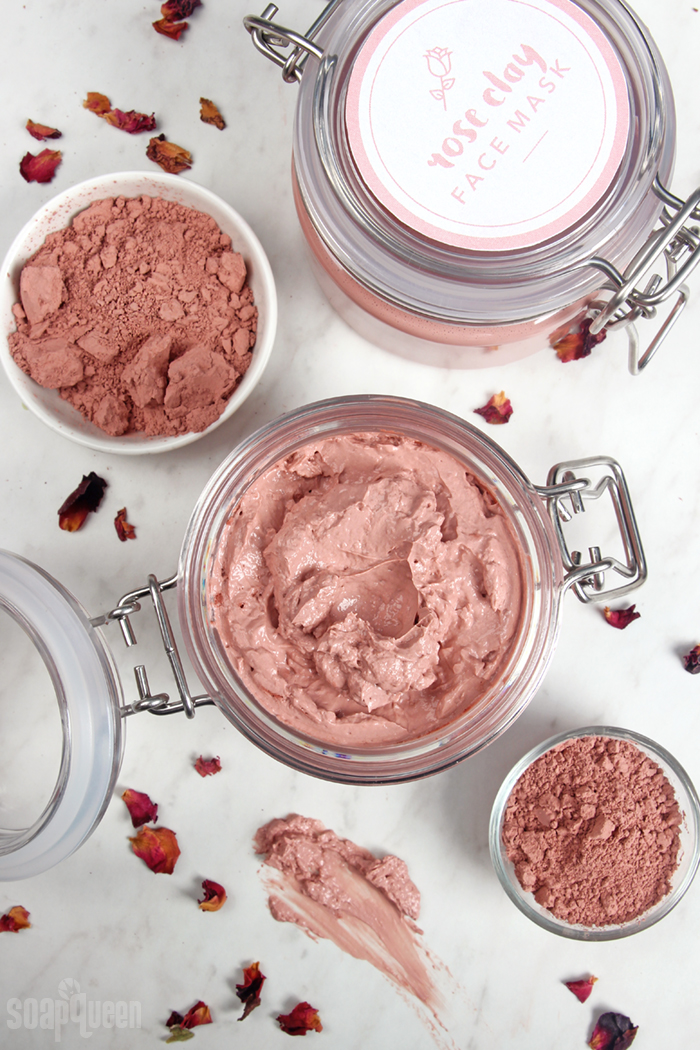
EQUIPMENT PREP: Disinfect your utensils by dipping them in a 5% bleach water solution and allowing to dry. This includes mixing containers, your stick blender, and any spoons or spatulas that may come in contact with your mask. Your products must be as free of germs, bacteria, and microbes as possible. To be safe, bleach water all your utensils.
CLAY PREP: In a small separate container, measure 3.5 ounces of kaolin clay and 1 ounce of rose clay. If you like, you can add them to the same container.
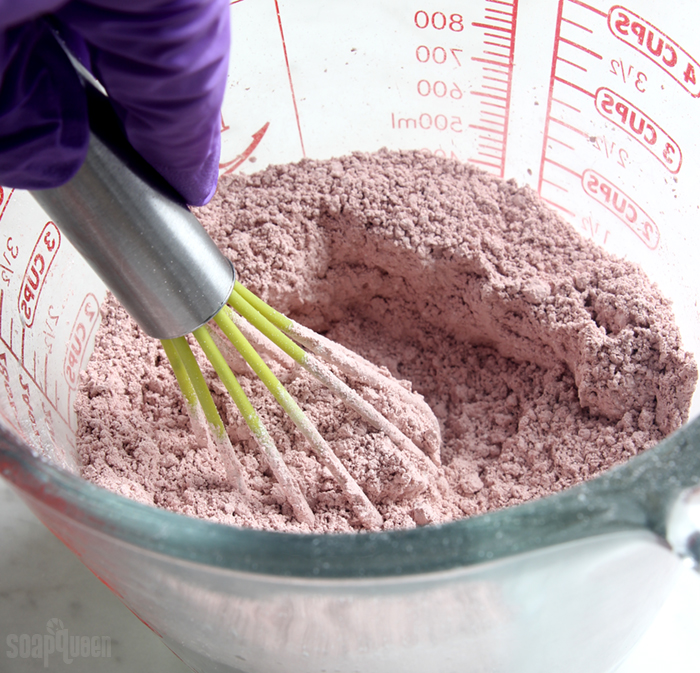 ONE: In a heat-safe container, combine the avocado oil, rosehip seed oil, BTMS-50 and Polawax. Heat the container in the microwave using 30-60 second bursts until the waxes have fully melted. Be careful when removing the container, as it will be quite hot. Set aside.
ONE: In a heat-safe container, combine the avocado oil, rosehip seed oil, BTMS-50 and Polawax. Heat the container in the microwave using 30-60 second bursts until the waxes have fully melted. Be careful when removing the container, as it will be quite hot. Set aside.
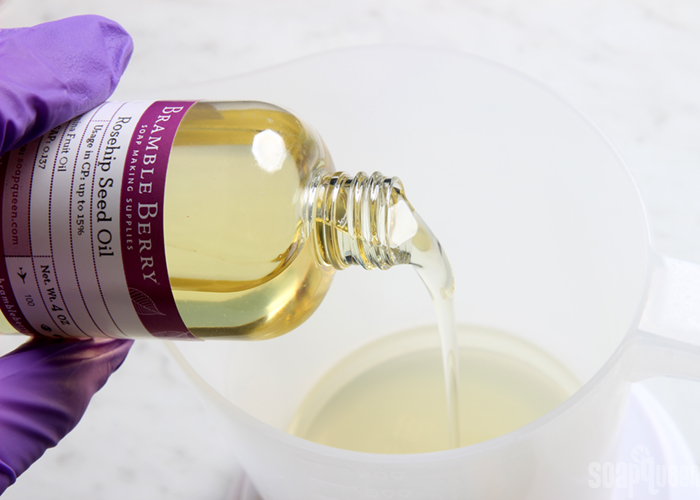 TWO: In a separate large container, heat the distilled water in the microwave (or on the stove top) until it reaches about 160-170 ° F. Once the water reaches the correct temperature, some of it may evaporate. Remeasure and add more distilled water if necessary until you have 21.4 ounces of hot water.
TWO: In a separate large container, heat the distilled water in the microwave (or on the stove top) until it reaches about 160-170 ° F. Once the water reaches the correct temperature, some of it may evaporate. Remeasure and add more distilled water if necessary until you have 21.4 ounces of hot water.
THREE: Check the temperatures of both containers. Each container should be about 160°-180° F. If the oil and wax mixture has cooled, place back into the microwave until fully melted. Place the stick blender into the water and burp it to help get rid of bubbles. Pour the oil and wax mixture into the water and use a spatula to make sure every little bit is added. Begin pulsing the stick blender. The mixture will take on a "milky" appearance once the water, oil and waxes have begun to emulsify. Continue to pulse and stir for about a minute.
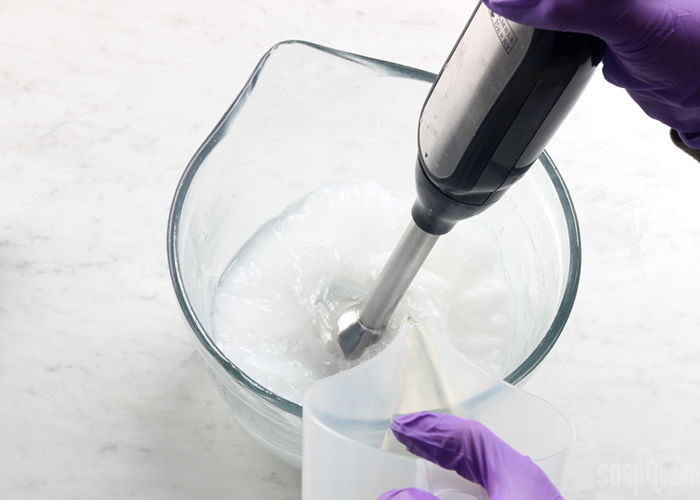
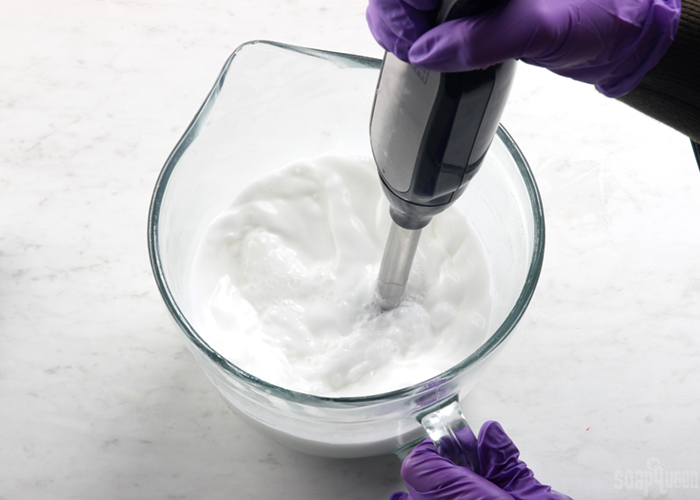 FOUR: Begin adding heaping spoonfuls of the clay mixture and pulsing the stick blender until combined. Continue adding the clay to the mixture and blending in small amounts until all the clay is added.
FOUR: Begin adding heaping spoonfuls of the clay mixture and pulsing the stick blender until combined. Continue adding the clay to the mixture and blending in small amounts until all the clay is added.
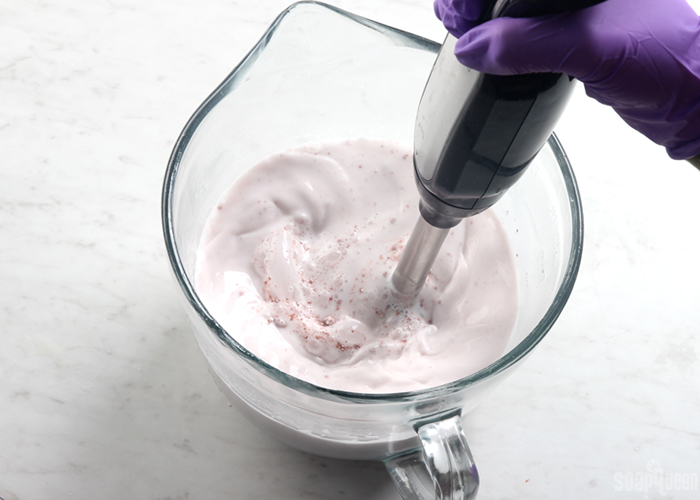
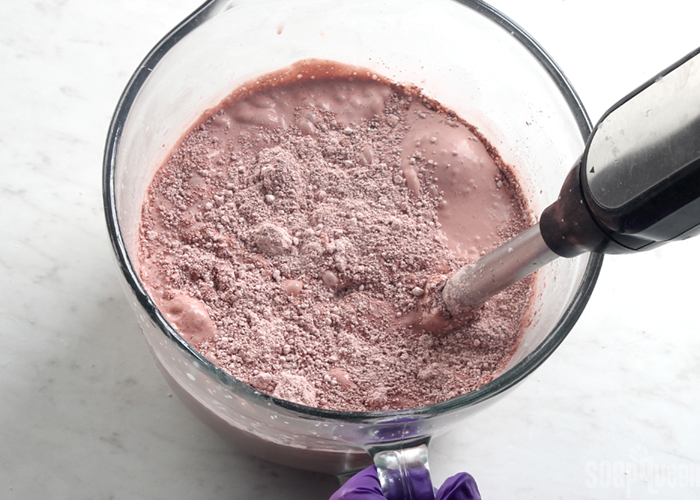 FIVE: Continue stick blending for about 1-2 minutes. Use a spatula to scrape down any clay that may be on the sides of the bowl. Check the temperature of the mixture. Once the mixture is about 130-140°F, add the Optiphen, rose absolute and chamomile extract. Stick blend (don't forget to burp the stick blender!) the ingredients in until fully mixed.
FIVE: Continue stick blending for about 1-2 minutes. Use a spatula to scrape down any clay that may be on the sides of the bowl. Check the temperature of the mixture. Once the mixture is about 130-140°F, add the Optiphen, rose absolute and chamomile extract. Stick blend (don't forget to burp the stick blender!) the ingredients in until fully mixed.
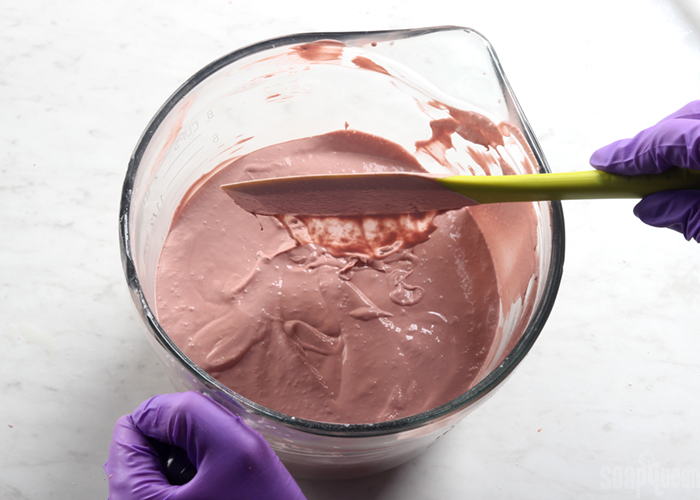
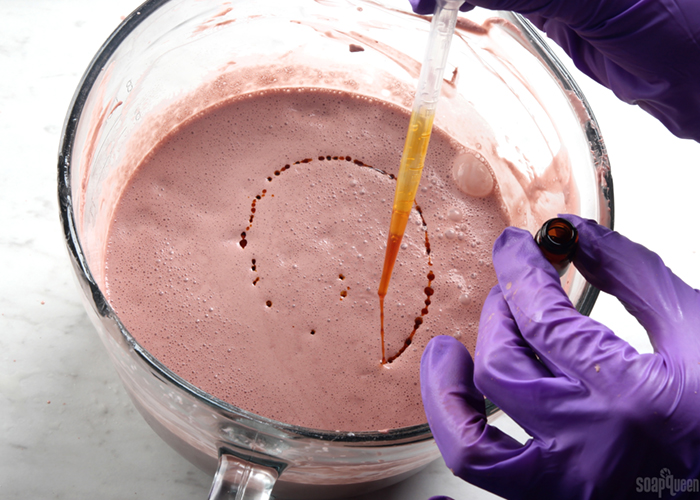 SEVEN: Pour the mixture into the bail jars. If you find you have a lot of bubbles on the top, you can spritz the top of the containers with 99% isopropyl alcohol to help get rid of some of them. Allow the containers to cool for several hours with the lid open to avoid condensation. Once fully cooled, the mixture will have become a thick, lotion-like texture. We found that the top of the mask does form a bit of a skin as it dries.
SEVEN: Pour the mixture into the bail jars. If you find you have a lot of bubbles on the top, you can spritz the top of the containers with 99% isopropyl alcohol to help get rid of some of them. Allow the containers to cool for several hours with the lid open to avoid condensation. Once fully cooled, the mixture will have become a thick, lotion-like texture. We found that the top of the mask does form a bit of a skin as it dries.
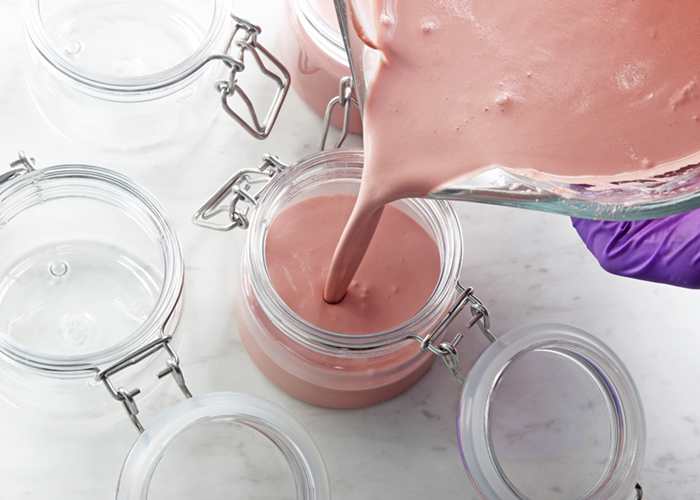
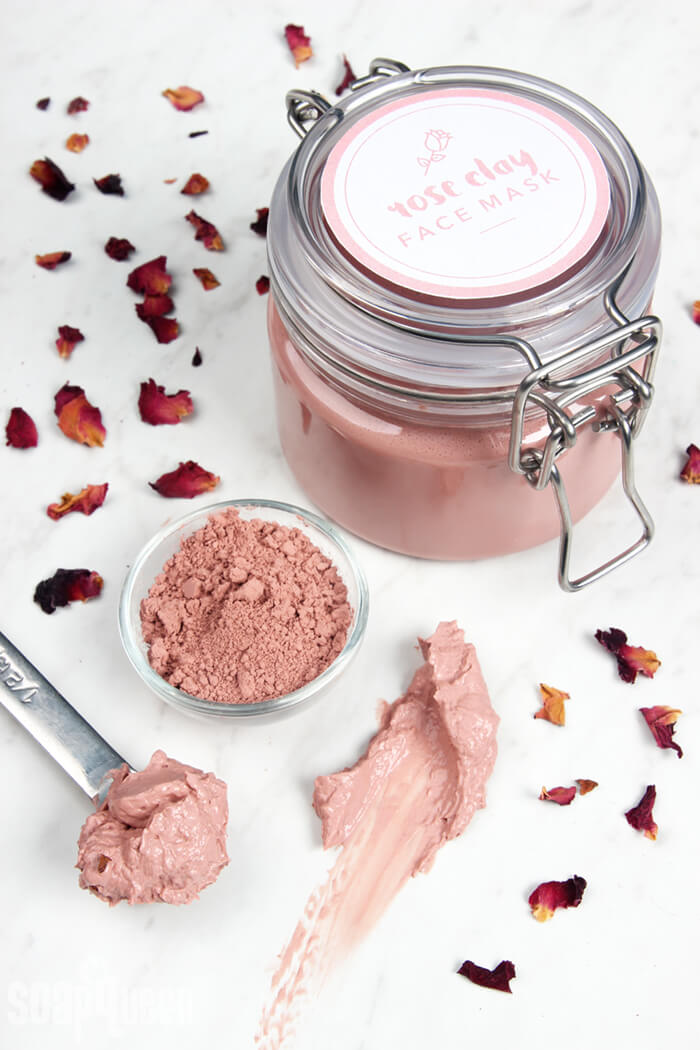
Rose Clay Face Mask
- Four Short 8 oz. Bail Jars
- Rose Clay Face Mask Template - Free PDF
- 21.4 oz. Distilled Water
- 1 oz. Rose Clay
- 3.5 oz. Kaolin Clay
- 1 oz. Rosehip Seed Oil
- 1.3 oz. Avocado Oil
- 0.8 oz. BTMS-50 Conditioning Emulsifier
- 1 oz. Polawax Emulsifying Wax
- 0.5 oz. Chamomile Extract
- 0.2 oz. Optiphen (preservative)
- 1 mL Rose Absolute
- Dropper
- In a heat-safe container, combine the avocado oil, rosehip seed oil, BTMS-50 and Polawax. Heat the container in the microwave using 30-60 second bursts until the waxes have fully melted. Be careful when removing the container, as it will be quite hot. Set aside.
- In a separate large container, heat the distilled water in the microwave (or on the stove top) until it reaches about 160-170 ° F. Once the water reaches the correct temperature, some of it may evaporate. Remeasure and add more distilled water if necessary until you have 21.4 ounces of hot water.
- Check the temperatures of both containers. Each container should be about 160°-180° F. If the oil and wax mixture has cooled, place back into the microwave until fully melted. Place the stick blender into the water and burp it to help get rid of bubbles. Pour the oil and wax mixture into the water and use a spatula to make sure every little bit is added. Begin pulsing the stick blender. The mixture will take on a "milky" appearance once the water, oil and waxes have begun to emulsify. Continue to pulse and stir for about a minute.
- Begin adding heaping spoonfuls of the clay mixture and pulsing the stick blender until combined. Continue adding the clay to the mixture and blending in small amounts until all the clay is added.
- Continue stick blending for about 1-2 minutes. Use a spatula to scrape down any clay that may be on the sides of the bowl. Check the temperature of the mixture. Once the mixture is about 130-140°F, add the Optiphen, rose absolute and chamomile extract. Stick blend (don't forget to burp the stick blender!) the ingredients in until fully mixed.
- Pour the mixture into the bail jars. If you find you have a lot of bubbles on the top, you can spritz the top of the containers with 99% isopropyl alcohol to help get rid of some of them. Allow the containers to cool for several hours with the lid open to avoid condensation. Once fully cooled, the mixture will have become a thick, lotion-like texture. We found that the top of the mask does form a bit of a skin as it dries.
3.3.3077
The post Rose Clay Face Mask DIY appeared first on Soap Queen.
Keine Kommentare:
Kommentar veröffentlichen